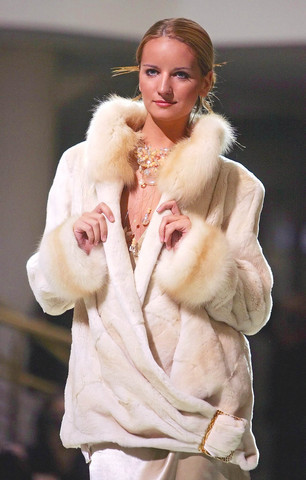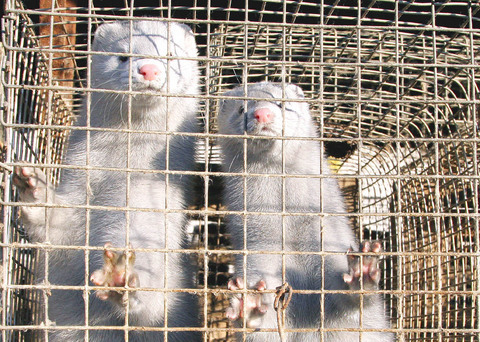From Soviet leaders to high society icons, a Russian fur coat was once seen as a desirable status symbol. But as Russians increasingly favor foreign imports, the Pushkino fur farm near Moscow is barely surviving.
The problems of Russia's fur industry are unrelated to ethical scruples of the kind that have put the industry under pressure in the West. It is the sector's inability to keep up with Western brands since the collapse of communism that is the real problem, observers say.
The farm at Pushkino was once the most celebrated in the Soviet Union. But a glance at its run-down buildings shows how far things have slipped.

PHOTO: EPA
"When I came here a year-and-a-half ago I was shocked," said Nikolai Yumanshev, a former space industry official recently installed as chief executive.
Yumanshev was brought in when the farm was bought by an energetic young millionaire, Denis Lavrov. It had already declared bankruptcy.
Even now, dealing with a legacy of neglect left by the previous state, management is proving an uphill task.

PHOTO: AFP
The animals at the farm were underfed, the mothers were giving birth to fewer and fewer offspring and the quality of the pelts had suffered.
"The water supply system, the electricity, the buildings, the heating system were all rotten," he said.
The picture is similar or worse throughout what remains of Russia's fur industry.
Of the 300 Russian fur farms that once provided 30 percent of world output, around 20 remain. Pushkino is one of just four left in the Moscow region.
"All the fur farms are closing, one after the other. We can't compete with China and Denmark," Pushkino's technical director, Vladimir Kudryavtsev, complained.
"China has taken over the fur market as far west as the Urals and Greek producers sell us poor quality items made from pelts that they buy here," the head of Pushkino's sewing workshop, Alexander Isayev, said.
Officials at Pushkino say they are gradually getting their farm back on track.
It now produces 100,000 pelts per year, including blue and silver fox, mink and sable -- the latter a Russian speciality. Pushkino claims to produce half of all sable -- sable coats fetching as much as US$150,000.
Nonetheless, the buildings remain in disarray and the company appears reluctant to copy Western fashion techniques, such as stret-ching pelts by machine to create a lighter fabric.
Yumanshev says there is still a market for more traditional heavier coats in a harsh climate like Russia's.
"In Europe, women wear furs like jewellery. They are beautiful of course, but in Russia the fur has to be thick and warm -- it's essential," he said. "We work by traditional methods here."
The problems of the company have more to do with the specifics of the Russian business environment, he insists.
These include the enormous size of the country it sells its products in and the farm's distance from the sea. The latter raises the cost of bringing in fish -- an important part of the animals' diet.
There are also difficulties intrinsic to the business, such as the fact that vixen are fertile for just three days per year.
But the biggest problem is the inefficient state bureaucracy.
Yumanshev says he spends much of his time battling local officials in order to obtain licenses and avoid fines for imaginary offenses.
"We get the impression the state is trying to destroy this profession," Kudryavtsev said.

Seven hundred job applications. One interview. Marco Mascaro arrived in Taiwan last year with a PhD in engineering physics and years of experience at a European research center. He thought his Gold Card would guarantee him a foothold in Taiwan’s job market. “It’s marketed as if Taiwan really needs you,” the 33-year-old Italian says. “The reality is that companies here don’t really need us.” The Employment Gold Card was designed to fix Taiwan’s labor shortage by offering foreign professionals a combined resident visa and open work permit valid for three years. But for many, like Mascaro, the welcome mat ends at the door. A

Last week gave us the droll little comedy of People’s Republic of China’s (PRC) consul general in Osaka posting a threat on X in response to Japanese Prime Minister Sanae Takaichi saying to the Diet that a Chinese attack on Taiwan may be an “existential threat” to Japan. That would allow Japanese Self Defence Forces to respond militarily. The PRC representative then said that if a “filthy neck sticks itself in uninvited, we will cut it off without a moment’s hesitation. Are you prepared for that?” This was widely, and probably deliberately, construed as a threat to behead Takaichi, though it

Nov. 17 to Nov. 23 When Kanori Ino surveyed Taipei’s Indigenous settlements in 1896, he found a culture that was fading. Although there was still a “clear line of distinction” between the Ketagalan people and the neighboring Han settlers that had been arriving over the previous 200 years, the former had largely adopted the customs and language of the latter. “Fortunately, some elders still remember their past customs and language. But if we do not hurry and record them now, future researchers will have nothing left but to weep amid the ruins of Indigenous settlements,” he wrote in the Journal of

If China attacks, will Taiwanese be willing to fight? Analysts of certain types obsess over questions like this, especially military analysts and those with an ax to grind as to whether Taiwan is worth defending, or should be cut loose to appease Beijing. Fellow columnist Michael Turton in “Notes from Central Taiwan: Willing to fight for the homeland” (Nov. 6, page 12) provides a superb analysis of this topic, how it is used and manipulated to political ends and what the underlying data shows. The problem is that most analysis is centered around polling data, which as Turton observes, “many of these